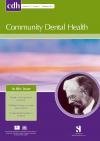Community Dental Health

- Cover Date:
- December 2012
- Print ISSN:
- 0265 539X
- Vol:
- 29
- Issue:
- 4
Dental erosion among 12 year-old Libyan schoolchildren
Objective: As there are limited data on dental erosion in Libya, the aim of this study was to assess the prevalence and severity of dental erosion in a sample of 12 year-old children in Benghazi, Libya. Basic research design: Cross-sectional observational study. Clinical setting: Elementary schools in Benghazi, Libya. Participants: A random sample of 791 12 year-old children (397 boys and 394 girls) attending 36 schools. Methods: Clinical dental examination for erosion using UK National Diet and Nutrition Survey (2000) criteria and self-completion questionnaire. Main outcome measures: The area and depth of dental erosion affecting the labial and palatal surfaces of the upper permanent incisors and occlusal surfaces of the first permanent molars. Results: Dental erosion was observed in 40.8% of subjects; into enamel affecting 32.5%, into dentine affecting 8.0% and into pulp affecting 0.3% of subjects. Based on area affected, 323 subjects (40.8%) exhibited dental erosion (code >0), with 32.6% of these subjects having erosion affecting more than two thirds of one or more surfaces examined. Mean total scores for dental erosion for all surfaces per mouth by area and by depth were both 2.69 (sd 3.81). Of the 9492 tooth surfaces examined, 2128 surfaces (22.4%) had dental erosion. Girls had more experience of erosion than boys at all levels of severity (p=0.001). Conclusions: In a cohort of 12 year-old Libyan schoolchildren, more than one third of children examined showed dental erosion, requiring clinical preventive counselling. Significantly more erosion occurred in girls than boys. Key words: dental erosion, children, Libya, prevalence
Introduction
Dental erosion is a multifactorial condition influenced by the interaction of chemical, biological and behavioural factors which explains why some individuals exhibit more erosion than others (Lussi and Jaeggi, 2008), and it is often associated with other forms of tooth wear such as abrasion and attrition. The term ‘tooth wear’ is used as a reflection of all three conditions (erosion, abrasion and attrition). Tooth wear in childhood is predominantly due to dental erosion and there is concern regarding its prevalence since it is largely preventable (Al-Dlaigan et al., 2001; Chadwick and Pendry, 2004; Walker et al., 2000). The aetiology of dental erosion is usually extrinsic or intrinsic acids, according to the case history; the main source in most cases being extrinsic acids from soft drinks in the diet (Johansson et al., 1996). As dental caries prevalence has declined in many populations, dental erosion has become increasingly recognised as a public health concern amongst children and adolescents (McGuire et al., 2009). The prevalence and severity of dental erosion varies widely between populations and ages; many cases are not identified until adulthood when they may be severe and difficult to treat, therefore, its early diagnosis and prevention are important. A number of epidemiological observational studies have assessed the prevalence of dental erosion in children and adolescents and it has been the subject of recent systematic review (Kreulen et al., 2010). The 2003 UK Child Dental Health Survey showed 12% of 12 year-olds had tooth surface loss (TSL) of buccal surfaces of permanent
upper incisors; 30% having lingual surface loss on these teeth. The proportions of 12 year-olds showing TSL on the occlusal surface of first permanent molars was 19%. Only 2% of 12 year-olds and 4% of 15 year-olds had TSL into dentine (Chadwick and Pendry, 2004). In 5-14 year-old Australians the prevalence of erosion was 25% in subjects with permanent teeth, while a more recent study assessed the prevalence of tooth surface loss in 12-14 year-old Sudanese schoolchildren and found overall mouth prevalence was 74.1%, with mild and moderate tooth surface loss respectively in 61.8% and 22.9% of maxillary teeth examined (Kazoullis et al., 2007; Sanhouri et al., 2010). Also recently, a study of 12 year-old Iranians, reported that the prevalence of dental erosion for the labial and palatal surfaces of upper incisors was 38.1% (Talebi et al., 2009). Similarly, a prevalence study carried out in 2003-4, of 13-19 year-old children and young adults in the United States, showed that 45.9% of subjects had erosive tooth wear in at least one tooth (McGuire et al., 2009). There are limited published epidemiological studies relating to the prevalence of dental erosion in Libya. Therefore, the aims of this study were to determine both the prevalence and severity of dental erosion and to examine gender differences in relation to the prevalence in a group of 12 year-olds in Benghazi, Libya. The relationship between dental erosion and parents’ education levels, a proxy measure of socioeconomic status, was also considered.
Correspondence to: Dr Anne Maguire, Centre for Oral Health Research, School of Dental Sciences, Newcastle University, Framlington Place, Newcastle upon Tyne, NE2 4BW, UK. Email: A.Maguire@ncl.ac.uk
- Article Price
- £15.00
- Institution Article Price
- £
- Page Start
- 279
- Page End
- 283
- Authors
- R. Huew, P.J.Waterhouse, P.J. Moynihan, A. Maguire
Articles from this issue
- Title
- Pg. Start
- Pg. End
- Recent trends in incidence and mortality of oral and pharyngeal cancer in Schleswig-Holstein in Northern Germany
- 268
- 273
- Children’s views on the experience of a visual examination and intra-oral photographs to detect dental caries in epidemiological studies
- 284
- 288
- Cost-effectiveness models for dental caries prevention programmes among Chilean schoolchildren
- 302
- 308
